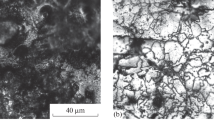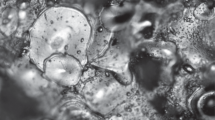Abstract—The possibility of using the technology of anodic plasma electrolytic carburizing in a nontoxic electrolyte to increase the microhardness and wear resistance of commercial-purity titanium is considered. The surface morphostructure and roughness the material after saturation, the microhardness distribution in the surface layer, and the tribological behavior of the modified surface are studied. Wear resistance tests are carried out under dry friction conditions using quenched tool alloy steel as a counterbody. Plasma electrolytic carburizing in an aqueous electrolyte containing ammonium chloride and glycerin is found to increase the surface hardness by 3.5 times, up to 900 HV0.01, due to the formation of a diffusion layer. The tribological behavior is influenced by high-temperature surface oxidation (leading to the formation of an outer oxide layer), the formation of a modified layer, and the surface relief of titanium. The coefficient of friction after treatment increases by 1.2 times and the mass wear decreases by 3.4 times as compared to the untreated surface of titanium parts.






Similar content being viewed by others
REFERENCES
A. N. Drobov, M. N. Bosyakov, and I. L. Pobol’, “Influence of ion-plasma nitriding on the wear resistance and the character of changing the surface roughness of titanium alloys VT1-0, VT6, and OT4-1,” Lit’e Metallurg., No. 2, 78–83 (2022).
Catalog of Products and Services of NPK Titanium Alloys (NITs Kurchatov Institute–TsNII KM Prometei, St. Petersburg, 2019).
B. P. Gritsenko, N. N. Koval’, Yu. F. Ivanov, K. V. Krukovskii, N. V. Girsova, and A. D. Teresov, “Increasing the wear resistance of commercial-purity VT1-0 titanium and VT6 alloy,” Izv. Samar. Nauch. Tsentra RAN 13 (4(3)), 1009–1013 (2011).
M. A. Spiridonov, A. A. Kukolev, L. E. Kuts, and N. A. Vavilina, “Effect of carburizing on the structure and properties of VT1-0 titanium alloy,” in Proceedings of Conference on the 2nd International Scientific Conference on Promising Development of Young Scientists (Kursk, 2021), pp. 177–180.
F. Czerwinski, “Thermochemical treatment of metals,” in Heat Treatment—Conventional and Novel Applications (IntechOpen, London, 2012), p. 422.
P. N. Belkin and S. A. Kusmanov, “Plasma electrolytic carburising of metals and alloys,” Surf. Eng. Appl. Electrochem. 57 (1), 19–50 (2021).
K. N. Ramazanov and I. S. Ramazanov, “Ionic nitriding of VT6 titanium alloy in a glow discharge with the hollow cathode effect,” Vestn. UGATU, No. 2, 41–46 (2014).
S. G. Ivanov, M. A. Gur’ev, S. A. Ivanova, I. A. Garmaeva, and A. M. Gur’ev, “Boriding of VT1-0 titanium from saturating coatings,” Grand Altai Research & Education, No. 1, 57–63 (2016).
M. Aliofkhazraei, D. D. Macdonald, E. Matykina, E. V. Parfenov, V. S. Egorkin, J. A. Curran, S. C. Troughton, S. L. Sinebryukhov, S. V. Gnedenkov, T. Lampke, F. Simchen, and H. F. Nabavi, “Review of plasma electrolytic oxidation of titanium substrates: mechanism, properties, applications and limitations,” Appl. Surf. Sci. Adv. 5, 100121 (2021).
S. A. Kusmanov, I. V. Tambovskii, I. A. Kusmanova, and P. N. Belkin, “Improving the wear resistance of VT22 titanium alloy by anodic plasma electrolytic boriding,” Surf. Eng. Appl. Electrochem. 57 (4), 419–424 (2021).
S. A. Kusmanov, I. V. Tambovskiy, S. A. Silkin, I. A. Kusmanova, and P. N. Belkin, “Anode plasma electrolytic borocarburising of alpha + beta-titanium alloy,” Surf. Interfaces. 21, 100717 (2020).
S. Kusmanov, I. Kusmanova, I. Tambovskiy, P. Belkin, and V. Parfenyuk, “Anodic plasma electrolytic nitrocarburising of Ti6Al4V alloy (SMT31),” Surf. Eng. 35 (3), 199–204 (2019).
Funding
This work was supported by the Russian Science Foundation (project no. 21-79-30058) and was performed on the equipment of the core facility of Moscow State University of Technology STANKIN.
Author information
Authors and Affiliations
Corresponding author
Ethics declarations
The authors declare that they have no conflicts of interest.
Additional information
Translated by K. Shakhlevich
Rights and permissions
About this article
Cite this article
Tambovskiy, I.V., Kusmanov, S.A., Mukhacheva, T.L. et al. Increasing the Hardness and Wear Resistance of Commercial-Purity Titanium by Anodic Plasma Electrolytic Carburizing. Russ. Metall. 2023, 565–571 (2023). https://doi.org/10.1134/S0036029523050117
Received:
Revised:
Accepted:
Published:
Issue Date:
DOI: https://doi.org/10.1134/S0036029523050117




